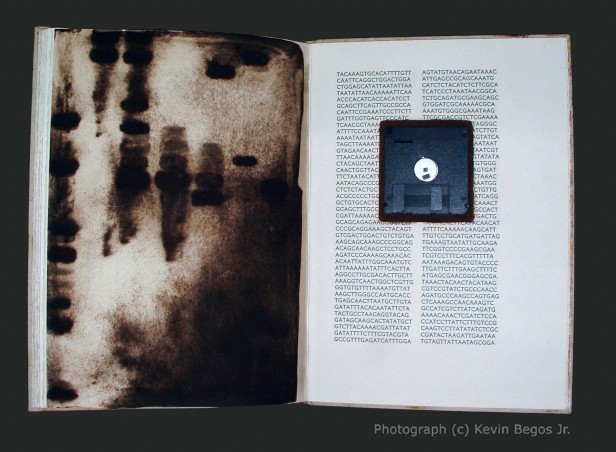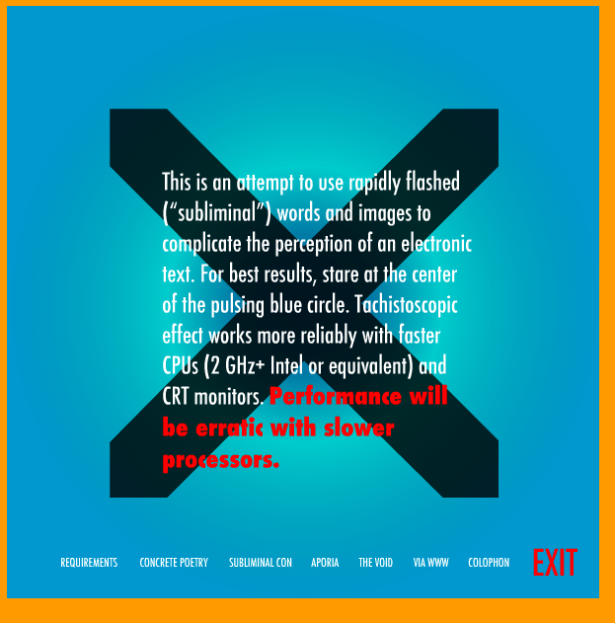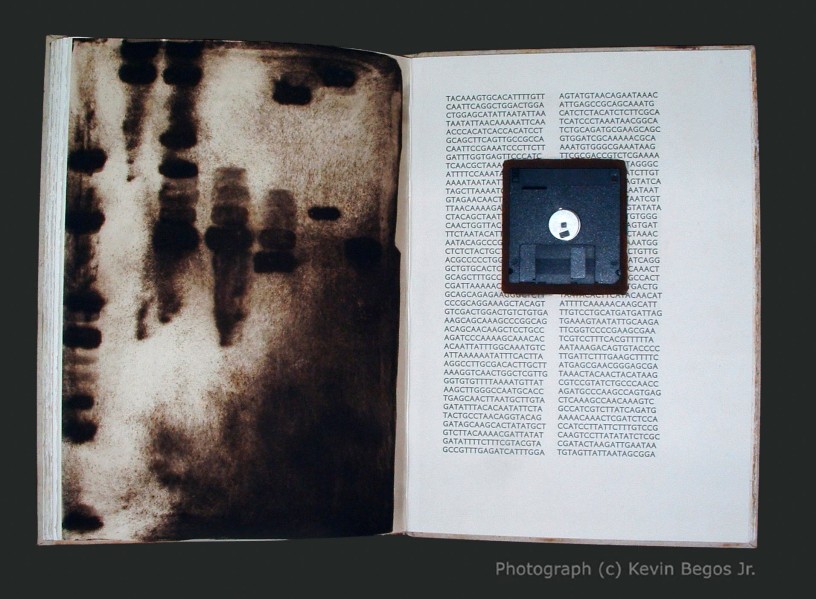Matthew Kirschenbaum’s account of the recovery of both the original video of Agrippa‘s unveiling at Manhattan’s Americas Society and the bit-level copy of the original Agrippa disk (a “disk image”) that allowed the team to produce emulated run throughs of William Gibson’s poem revealed something quite interesting regarding the preservation and reproduction of the poetic project. Kirschenbaum notes that, while the emulator (a software duplication of the functions of a computing environment or platform) allows for the viewing of Gibson’s poem multiple times (as opposed to the intended single run of the disk that would be rendered unusable via a program, entitled “MAKE-SOME-SHIT,” that wrote a fake nucleotide sequence over the disk’s necessary run routines), in order to do so, one must repeatedly mount a new copy of the disk image every time one would want to run Agrippa within the emulator, due to the emulated program overwriting its run routines as originally designed (DuPont 7). Thus, a user is confronted with the absurd circumstance of trying to use emulation to circumvent a digital work’s fundamental logic and in a sense doing so, yet still having to create the object anew every time he or she wants to view it because, while one can repeat the run endlessly, it always ends with the Agrippa emulation being unusable.
The perseverance of Agrippa‘s fundamentally anti-preservationist design brings forth many questions regarding the relationship between the necessities of digital preservation (specifically, for my research interests, the preservation of electronic literature), the use of tools such as emulators and containers to do so, and digital poetics in a more general sense. I’ll use this post to briefly discuss two of those questions: first, how does the process of preserving a digital work change one’s understanding of the poetics of said work? To state the question another way, I want to understand how this process of preservation, particularly when it comes in the form of emulation or containerization, emphasize aspects of a work’s poetics that may not have been as prevalent in its “original” form. Secondly, I want to investigate how the reader/user’s interaction (or interfacing) with the newly preserved digital work changes after the process of preservation results in said work’s reimplementation. By beginning to answer these two questions, I want to move toward an understanding of the role that digital preservation tools and techniques play in configuring and reconfiguring one’s understanding of what a work of electronic literature or digital art is, and how that will play into research on objects that are rapidly going unplayable in their original mode.
This line of thought is inspired by a section of Garrett Stewart’s essay “Transmedium” in which he describes what he terms “conceptualism 2.0,” artworks that “[bring] to light certain invisible technological affordances and their tacit relation to our pluralized and ever more pervasive category of ‘the media’.” In art objects such as these, “technical obliqueness and mystery are the new norm in these installation projects, their display awaiting ‘behind-the-scenes’ discourse and disclosure by extensive wall-plaque or catalogue explication. In such cases we don’t really know what we are seeing until we are told how it is shown to us” (Stewart). It’s fruitful to think about Stewart’s concept in relation to the process of producing an emulated run of Agrippa and the larger Agrippa Files project because, in short, there’s a difference between speculating about the operations of the work and understanding the material processes by which certain effects are created. The work that a reader/user does in traversing that difference can yield vitally important reformulations of one’s understanding of how a digital work or piece of electronic literature is materially constituted.

(Photograph courtesy of The Agrippa Files)
Alan Liu, Agrippa Files project director (and the reason why this blog even exists, by the way), touches on this effect of this shift in perspective that preservation processes can engender when he notes that cracking the Agrippa code, in demystifying a key aspect of the work, also “reconstitutes the work’s mystery- it’s irreducible strangeness- in new ways.” Liu is discussing the overwriting program that presents itself as re-encryption at the end of the disk’s run (really a decryption program that is run on already decrypted text, turning it into gibberish), but this can also apply to Agrippa‘s emulation wholesale. By putting Agrippa into contact with a software process that is fundamentally at odds with its governing design logic, the Agrippa Files team ended up making explicit aspects of its poetics that may have remained implicit or tacit in its original form. When a reader/user wants to run Agrippa over and over again, and has to remount the disk image every time he or she wants to do so, that reinforces and makes explicit the underlying concept inherent in the work’s design in a very different way than originally intended by Gibson, Kevin Begos Jr, and Dennis Ashbaugh. The work still “destroys” itself, as Begos originally conceived of it doing and as it was designed to do, and in order to use the emulator to reread Agrippa, one must not only run it, but must reconstruct it to be run itself, thus reinforcing the “destruction” aspect of the piece in a manner materially specific to both the structure of the disk/disk image and the medium of implementation. This also constitutes an explicit encounter with the fundamental logic of emulators and containers as well, as they are designed (containers in particular) to be both modifiable and radically ephemeral. Far from creating a lasting software application or digital work, the appeal of emulators and containers, at least partially, is that they are incredibly easy to reconfigure to changing specifications (either yours or industry’s). If you want to change something about the composition of your container or you want to run something different in your emulator, simply shut it down, change it, and reload it. In this dual manner, the original disk implementation provides a fundamentally different view of its poetics than the emulator/disk image implementation.
When you consider the inherent destructiveness of Agrippa‘s software design in relation to the means by which the disk is made unusable, then one major question, one left tacit and not touched upon by previous interlocutors, emerges for the reader/user to consider. This is the question of the structure of Agrippa, its “genetics,” so to speak: how is the “genetic makeup” changed in over the course of its run (in this sense, it has an affinity with a project developed a couple decades after Agrippa, that being Christian Bök’s The Xenotext)? Despite the fact that Kevin Begos Jr. refers to the use of the fake nucleotide sequence in Agrippa as “just ‘ACTG’ letters” as opposed to an actual text, and Liu glosses over this discovery in favor of his Fantasia metaphor (“if the previous steps in the illusion are an abrakadabra, then MAKE-SOME-SHIT- to give it a more charming name- was shazam!”), there is an important consideration implicit in the use of this sequence to render the disk unusable. It brings to the fore and makes material the question of whether the run of Agrippa has actually created something completely different from what it was before the disk was ran. It was a running digital object (to use Yuk Hui’s terminology for “objects that take shape on a screen or hide in the back end of a computer program, composed of data and regulated by structures or schemas,” one of those structures being the “formal regimen” of software) that was made into a non-functional digital object, and brings to light questions of how its myriad modes of transmission have transformed the object and made it into something different from how it was materially composed (Hui 1; Kirschenbaum 233). This problematic is exacerbated in the process of preserving Agrippa, as digital preservation requires that code be revealed so that “data can be reconstituted in keeping with its original intent” (Kirschenbaum 234). This requirement, in the case of Agrippa, is practically implemented in the form of an emulator: “a program that effectively implements a hardware computer in software- well enough that binary programs for that computer can run in the emulator” (Liu et. al). What you get with the emulaton of Agrippa is the problematic of the “genetic makeup” of the work being shifted back to the implementation stage: is the digital object called Agrippa that the reader/user runs in a Macintosh System 7 emulator really the same thing as the program on the disk that one runs on his or her computer, also titled Agrippa, especially given that the emulated version can do completely different things from the original, disk-run version?
This question leads me to my second consideration: how does the reimplementation of a work of electronic literature or a digital artwork in general modify the way in which a reader/user interfaces with said work? It’s fruitful to begin thinking this question through in terms of the general logic of medium-specificity that permeates not only theories of electronic literature (the context in which Katherine Hayles’s Writing Machines introduces the concept) but theories of conceptual art/poetry, the 20th century avant-garde, and even media theory and media studies in general. Without delving too far into such a capacious claim (a subject for another blog post), this logic of medium-specificity stipulates that the theories, philosophies, concepts, cultural logics, etc. that a reader/user of some cultural object will experience are reified in the form of the media object itself, whether it be a book, an advertisement, or a smartphone. This logic can be distilled into a single sentence: the medium is the message.
Thus, a necessary question for the reader/user of the emulated run of Agrippa, and the reader/user of a containerized implementation of anything, emerges. Is an interaction with this implementation of the digital object the same as an interaction with the original object, given that it is instantiated in a materially different manner? For Agrippa, the question seems like it would be an obvious “no,” given that the reader/user can fundamentally do different things with this version of Agrippa than you could with the original disk run version. However, I want to use a different example from the world of electronic literature: that of William Poundstone’s Project for Tachistoscope {Bottomless Pit}. Let’s say, hypothetically, that the reader/user of Poundstone’s work is, in fact, a trio of researchers and that they use a decompiler to recover the .fla source file of the work in order to study Poundstone’s original source code. These researchers find that the structure of the work defies their expectations and, rather than reproducing an .fla file that contains all of the aspects of the work including the story and subliminal, flashing text, see that “the code contained a call to load the text from an external file named BP.txt” and draw the subliminal from another list loaded similarly to BP.txt (Pressman, Marino, and Douglass 30). The researchers thus decide to modify Project for Tachistoscope in three particular ways: they first replace BP.txt with another text file containing a different story; then they preserve the original version of Poundstone’s work (to an extent) by modifying a Netcapsule Dockerfile to produce a containerized Chrome browser that will theoretically access the work in perpetuity; and finally, the three reimplement the work in JavaScript/jQuery format. At what point are they looking at and interfacing with the same digital object as Poundstone’s original Project for Tachistoscope?

(Screenshot courtesy of ELMCIP)
Even when one takes at face value Pressman, Marino, and Douglass’s statement that “Project…is technically and programmatically a reading machine” that a reader/user employs as a medium for viewing text, answering this question is a tangled proposition (especially when this is considered, in some respects) (31). But one could answer the question very simply in this manner: if one understands a digital object to be specifically composed of data that is regulated by the formal regimen of software; understands the act of interfacing with a computational system underlying a digital object as “the culmination, expression, or concealment of an active relation between” the user and the system; and takes seriously the logic of medium-specificity, then one will answer that they never really are looking at the same object as the original Project for Tachistoscope (Hookway 14). Even though all three implementations of Poundstone’s work run in the same manner as the original, the material composition of the work is different, and thus the way in which the reader/user interfaces with the work is different even if the most base of interfacial habits have not been modified in any perceptible way. Once the poetics of the work are changed in such a manner, one can make a very real argument that the “genetic” modification of the work precludes it from being called the same work, per se. This may seem pedantic, and electronic literature scholars and authors such as Serge Bouchardon and Bruno Bachimont would disagree with me by saying that “the file isn’t the work as it isn’t what the reader perceives.” However, given the example of Agrippa, and the very real possibility that many more works of electronic literature will be going the way of Agrippa in the future, it is important to consider how the act of preservation can and will change the works researchers will study and interface with. I say this because, in the future, scholars of electronic literature and digital poetics may be facing a situation where their objects of study cannot be run in their original instantiation and must be emulated or containerized in some manner. If and when such a circumstance comes to pass, it will be worth one’s while to think about how our methods of preservation and study modify both the digital objects themselves, as well as our understandings of said objects.
Works Cited:
Begos Jr, Kevin. “Interview with Kevin Begos, Jr.” The Agrippa Files, Transcriptions Project, 17 December 2005, http://agrippa.english.ucsb.edu/hehmeyer-paxton-interview-with-kevin-begos-jr. Accessed 17 March 2017.
Bouchardon, Serge and Bruno Bachimont. “Preservation of Digital Literary Works: Another Model of Memory?” E-Poetry 2009, Electronic Poetry Center, 23 May 2009 to 26 May 2009, Centro de Cultura Contemporanea de Barcelona, Barcelona, Spain.
DuPont, Quinn. “Cracking the Agrippa Code:Cryptography for the Digital Humanities.” Scholarly Research and Communication, Volume 4, Issue 3, 2013, http://src-online.ca/index.php/src/article/view/126/242. Accessed 17 March 2017.
Hookway, Brandon. Interface. The MIT Press, 2014.
Hui, Yuk. On the Existence of Digital Objects. U of Minnesota P, 2016.
Kirschenbaum, Matthew G. Mechanisms: New Media and the Forensic Imagination. The MIT Press, 2008.
Kirschenbaum, Matthew G., Doug Reside and Alan Liu. “No Round Trip: Two New Primary Sources for Agrippa.” The Agrippa Files, Transcriptions Project, 5 December 2008, http://agrippa.english.ucsb.edu/kirschenbaum-matthew-g-with-doug-reside-and-alan-liu-no-round-trip-two-new-primary-sources-for-agrippa. Accessed 17 March 2017.
Liu, Alan, et. al. “Born-Again Bits: A Framework for Migrating Electronic Literature.” Electronic Literature Organization, 5 August 2005, https://eliterature.org/pad/bab.html. Accessed 28 Feb. 2017.
Liu, Alan, et. al. “Cracking the Agrippa Code: How the Disk Worked.” The Agrippa Files, Transcriptions Project, 22 June 2014, http://agrippa.english.ucsb.edu/post/documents-subcategories/the-disk-and-its-code/cracking-the-agrippa-code-how-the-disk-worked. Accessed 17 March 2017.
Pressman, Jessica, Mark Marino, and Jeremy Douglass. Reading Project: A Collaborative Analysis of William Poundstone’s Project for Tachistoscope {Bottomless Pit}. U of Iowa P, 2015.
Stewart, Garrett. “Transmedium.” The Iowa Review, Volume 44, Issue 3, 2014/15, https://iowareview.org/from-the-issue/volume-44-issue-3-%E2%80%94winter-201415/transmedium. Accessed 21 Feb. 2017.
